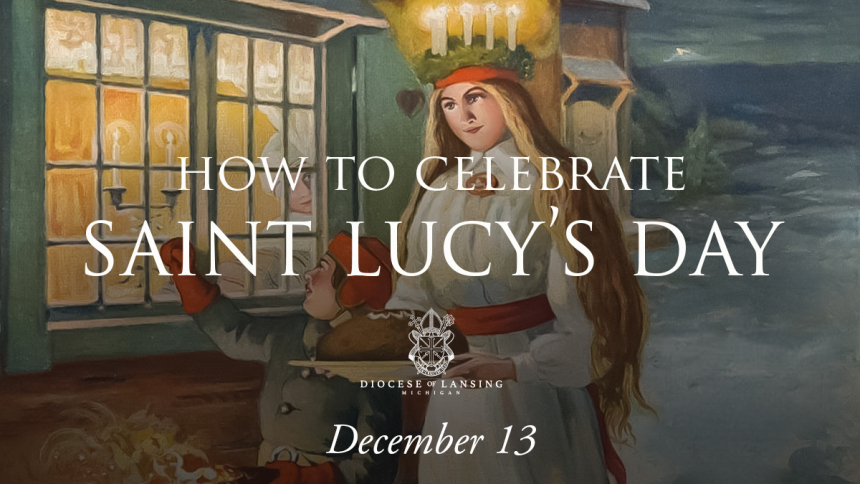
Have you ever heard of Saint Lucy of Syracuse? She was a young martyr who lived in the 4th century in Italy and is celebrated in many Scandinavian countries on her feast day, December 13. That's today! Each year on Saint Lucy's feast day, children dress up in all white, wear a crown of candles and bake Saint Lucy "eyeball" buns to share with their loved ones and friends. Why? And how? Father-of-five, Benjamin Stenlund from DeWitt, now recounts his recent attempts to celebrate the Feast of Saint Lucy with his wife and children…including his youngest daughter, Lucy! Benjamin writes:
"Being that I am from Minnesota, with a Swedish last name, and a grandfather that grew up speaking Swedish in the home, one would think that I ought to be an expert on the Scandinavian traditions surrounding St. Lucy. Alas! I am not. My most recent Swedish ancestors were Protestants, of the sort for whom anything smacking of popery was akin to devilry. So, veneration of saints was very much out of the picture."
"That being said, however, such traditions are not dead! It was in college that I first heard of St. Lucy and the idea of nocturnal processions of girls wearing lighted candles in their hair, and I was intrigued. Some friends of mine had a deep devotion to Lucy and they loved to promote her. I paid some attention to it, but not as much as I could have — veneration of saints was still new to me back then, and seemed weird."
"Fast forward a decade or two, and I named a daughter Lucy, and as soon as she could keep something on her head I put an evergreen crown with (unlit) candles on it there. There is little more adorable than little girls in white dresses with red sashes, wearing crowns, and frolicking around the house."
"Inspired by Kendra Tierney’s book on liturgical living, The Catholic All Year Compendium, we also try to have Saint Lucy’s Eyeballs for breakfast. These eyeballs are not anything macabre, however (though that has not stopped me from joking with my daughter Lucy about eating her real eyeballs — oddly, she always says “no”). They consist of a cinnamon roll rolled first one way and then the other, making a sort of spiraling “S” shape with the dough, frosted white, with a raisin (or other dried fruit) in the center of each spiral to be the pupil. These can be done with homemade cinnamon rolls or with the cinnamon-roll-in-a-tube stuff found at the grocery store, just half unrolled and then rolled the other way before baking. We have done both, depending on how much time and energy we had that particular year."
"Traditionalists will insist that they ought to be saffron buns shaped the same way (the spiraling “S”), not cinnamon rolls, and I could not agree more; but saffron is too expensive for me to stock, and really, as G. K. Chesterton once said, “If a thing is worth doing, it is worth doing badly.” I won’t let a less-than-perfect celebration keep me from celebrating, in other words."
"I wish I could say that we have some sort of traditional Sicilian or even Swedish dish for supper, but I’m not sure that we do consistently. Meatballs with red sauce sounds good, though, or really any kind of Italian-inspired dish. As long as you can claim that it looks like it has eyeballs, or the blood of a martyr, or something that will catch the imagination of kids."
"At this point, perhaps, you are asking why one would wish to eat eyeballs, or do anything with eyeballs, on the feast of St. Lucy (or any other day, probably!). Well, St. Lucy was a beautiful Sicilian girl, born to rich parents, but since her father died when she was young, her mother wished to marry her to a rich young man to secure her future, for the mother was suffering from some sort of bleeding disorder. The problem was that Lucy had already vowed perpetual virginity to the Lord, and the thwarted suitor denounced her as a Christian."
"Before she was denounced and killed, and probably causing the denouncing and killing, Lucy and her mother visited the shrine of St. Agatha, also a Sicilian martyr, who cured Lucy’s mother of her bleeding disorder, whereupon in thanksgiving Lucy started to give away all their money and possessions. The rich suitor evidently did not want his future bride to be poor."
"On other details, accounts vary, including the fate of her beautiful eyes; in one, she plucked her own eyes out to discourage a young man’s attentions; in another, she had them gouged out by the torturers. As a result, she is the patron of eye ailments."
"Now, about those candles. Since the name Lucy comes from the Latin word for light (lux), and her feast falls during the darkest time of the year, people from places where it gets really dark in the winter, like Scandinavia, like to have lots of light on her feast. The white dress symbolizes virginal purity and the red sash her martyr’s death."
"And then you process around and eat saffron rolls (or cinnamon rolls, and process in the day, since bedtime is important, and don’t light the candles...because I don’t want to burn all the golden hair off the head of my young daughter)."
"Other places around the world give gifts on St. Lucy’s Day, as the saint and her donkey visit each house to give presents, not unlike what I associate with Santa Claus; folks even leave treats for Lucy and some hay for her donkey! We don’t do that. Maybe we will, someday, but with St. Nicholas’ Day a week earlier, and Christmas less than two weeks later, it’s just too many gifts. Even if they are small ones, it becomes far too much for me to plan. Cinnamon rolls, pasta, and candle crowns I can do."
Santa Lucia, ora pro nobis!
